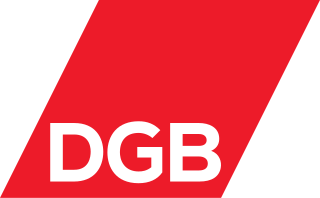Related Research Articles

The Free German Trade Union Federation was the sole national trade union centre of the German Democratic Republic which existed from 1946 to 1990. As a mass organisation of the GDR, nominally representing all workers, the FDGB was a constituent member of the National Front. The leaders of the FDGB were also senior members of the ruling Socialist Unity Party of Germany (SED).

The German Trade Union Confederation is an umbrella organisation for eight German trade unions, in total representing more than 6 million people. It was founded in Munich, 12 October 1949.

The Education and Science Workers’ Union is a trade union in Germany. It has a membership of 280,343 and is one of eight industrial affiliates of the German Confederation of Trade Unions. Most members are teachers, but it also represents day care workers, social workers, private educators, researchers and professors.
Trade unions in Germany have a history reaching back to the German revolution in 1848, and still play an important role in the German economy and society.
The General German Trade Union Federation was a confederation of German trade unions in Germany founded during the Weimar Republic. It was founded in 1919 and was initially powerful enough to organize a general strike in 1920 against a right-wing coup d'état. After the 1929 Wall Street crash, the ensuing global financial crisis caused widespread unemployment. The ADGB suffered a dramatic loss of membership, both from unemployment and political squabbles. By the time the Nazis seized control of the government, the ADGB's leadership had distanced itself from the Social Democratic Party of Germany (SPD) and was openly cooperating with Nazis in an attempt to keep the organization alive. Nonetheless, on May 2, 1933, the SA and SS stormed the offices of the ADGB and its member trade unions, seized their assets and arrested their leaders, crushing the organization.

The GDR Union of Journalists was a professional association of journalists in East Germany. VdJ organized news, press, radio and television journalists, as well as press officers, publishing staff, cartoonists, documentarists and teachers of journalism. VJD conducted trainings for journalists, on behalf of the Ministry for Higher and Professional Education. The offices of the VdJ were located at Friedrichstraße 101, Berlin, in the Admiralspalast.
The Industrial Union of Metal was a trade union representing workers in the metal and electronic industries in East Germany.
The Union of Trade, Food and Luxuries was a trade union representing workers in various related industries in East Germany.
The Industrial Union of Textiles, Clothing and Leather was a trade union representing workers in the textile, clothing, leather, and tobacco industries in East Germany.
The Industrial Union of Transport and Communication was a trade union representing workers in the transport and communication sectors in East Germany.
The Union of Employees of State Organs and the Communal Economy was a trade union representing workers in state organisations, the finance and legal sector, and services provided by local government.
The Industrial Union of Mining and Energy was a trade union representing the mining, energy and water industries in East Germany.
The Union of Land, Food and Forests was a trade union representing workers in various related industries in East Germany.
The Union of Healthcare was a trade union representing healthcare workers in East Germany.
The Industrial Union of Chemicals, Glass and Ceramics was a trade union representing workers in various industries in East Germany.
The Industrial Union of Construction and Wood was a trade union representing construction and wood workers in East Germany.
The Industrial Union of Printing and Paper was a trade union representing workers in the printing industry in East Germany.
The Union of Academic Research was a trade union representing university and college staff and those in related jobs in East Germany.
The Union of Art was a trade union representing art, media and heritage workers in East Germany.
Werner Peplowski is a former German trade union leader.
References
- 1 2 "Gew. Instruction and education (1946-90)". FDGB-Lexikon. Friedrich Ebert Stiftung. Retrieved 9 July 2020.
- ↑ Wirtz, W. Willard (1965). Directory of Labor Organizations, Europe. Washington DC: United States Bureau of International Labor Affairs. pp. 11.1–11.7.